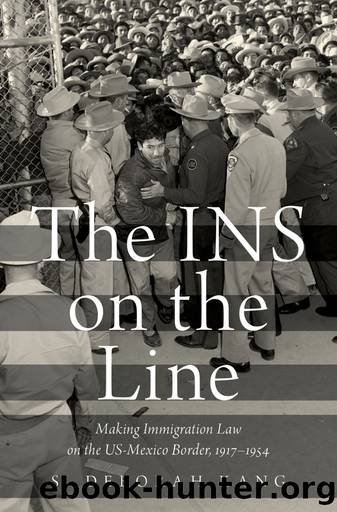The INS on the Line by S. Deborah Kang

Author:S. Deborah Kang
Language: eng
Format: epub
Publisher: Oxford University Press
Published: 2016-08-15T00:00:00+00:00
Conclusion
After 9/11, concerns surrounding border security transformed the US–Mexico border once again. Congress reorganized the INS, passed several border enforcement measures, and, for the first time in history, routinely appropriated immigration agencies more money than they requested. By 2012, Congress was spending a record $100 billion per year on immigration and border enforcement. By 2014, US Customs and Border Protection (CBP), the successor to the Border Patrol, was the largest law enforcement agency in the country, employing a total of 60,000 agents and administrators.1 And by 2012, CBP constructed 651 miles of a 700-mile border fence mandated by the Secure Fence Act of 2006.2 Accompanying the new fence was an array of surveillance technologies, including predator drones, video cameras, mobile license plate readers, and thermal imaging systems. More than ever before, the border came to resemble a militarized zone.
Despite the unprecedented buildup of the nation’s border enforcement capacities after 9/11, the border remained open. CBP, like the immigration officials of the twentieth century, continued to facilitate the flow of local residents, laborers, tourists, and traders. Rather than view this situation with alarm, CBP leaders described it as an integral component of their institutional mission. As the agency’s website states: “[CBP] is charged with keeping terrorists and their weapons out of the United States while facilitating lawful international trade and travel.”3 At times, federal agencies have been so sensitive to the socioeconomic needs of the borderlands that they, in the words of Janet Napolitano, former Secretary of the Department of Homeland Security, “emphasized and worked to improve the flow through the border of legal travel and trade” and made border enforcement their second priority.4
In a recent expose of the CBP, Garrett Graff, editor of Politico Magazine, characterized the agency’s dual role as a “quirk.”5 Yet this book reveals that the complexity of CBP practices derives in part from the institutional orientation and legal precedents established by its predecessor, the INS. Over the course of the twentieth century, the INS in the Southwest created laws and policies that opened and closed the border. As nativism and national security informed initiatives to bolster immigration law enforcement, economic, political, and diplomatic imperatives led the agency to devise procedures that sustained the transnational character of the borderlands. These legal innovations reflected the agency’s view of the US–Mexico border as much more than a dividing line or symbol of national sovereignty. INS officials also construed and constructed the border as an economic zone, a transnational social space, and a vast legal jurisdiction.
In the popular and scholarly imagination, the INS functioned as a law enforcement agency, fulfilling its mandate to close the borders to unwanted immigrants. This book unsettles this notion, tracing the ways in which the INS served as a lawmaking body as well as a law enforcement agency. While Congress and the courts provided the outlines of a federal immigration policy, local INS officials articulated that policy in more detail, modifying, inventing, and even ignoring it in response to regional and transnational needs. What resulted
Download
This site does not store any files on its server. We only index and link to content provided by other sites. Please contact the content providers to delete copyright contents if any and email us, we'll remove relevant links or contents immediately.
| Africa | Americas |
| Arctic & Antarctica | Asia |
| Australia & Oceania | Europe |
| Middle East | Russia |
| United States | World |
| Ancient Civilizations | Military |
| Historical Study & Educational Resources |
The Dawn of Everything by David Graeber & David Wengrow(1654)
The Bomber Mafia by Malcolm Gladwell(1588)
Facing the Mountain by Daniel James Brown(1504)
Submerged Prehistory by Benjamin Jonathan; & Clive Bonsall & Catriona Pickard & Anders Fischer(1420)
Wandering in Strange Lands by Morgan Jerkins(1374)
Tip Top by Bill James(1351)
Driving While Brown: Sheriff Joe Arpaio Versus the Latino Resistance by Terry Greene Sterling & Jude Joffe-Block(1339)
Evil Geniuses: The Unmaking of America: A Recent History by Kurt Andersen(1320)
Red Roulette : An Insider's Story of Wealth, Power, Corruption, and Vengeance in Today's China (9781982156176) by Shum Desmond(1316)
The Way of Fire and Ice: The Living Tradition of Norse Paganism by Ryan Smith(1305)
American Kompromat by Craig Unger(1271)
It Was All a Lie by Stuart Stevens;(1265)
F*cking History by The Captain(1254)
American Dreams by Unknown(1238)
Evil Geniuses by Kurt Andersen(1225)
Treasure Islands: Tax Havens and the Men who Stole the World by Nicholas Shaxson(1222)
White House Inc. by Dan Alexander(1181)
The First Conspiracy by Brad Meltzer & Josh Mensch(1140)
The Fifteen Biggest Lies about the Economy: And Everything Else the Right Doesn't Want You to Know about Taxes, Jobs, and Corporate America by Joshua Holland(1092)
